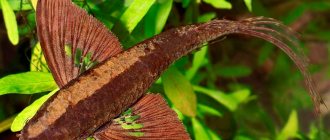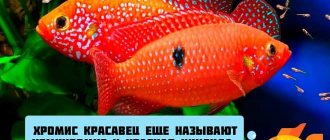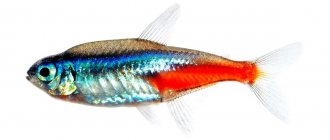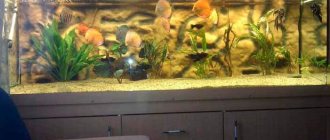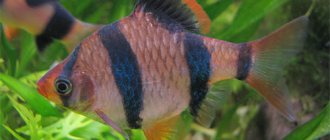Description
The butterfly will decorate the aquarium of experienced and amateur aquarists. Ramirezi fish are not suitable for beginner aquarists due to their sensitivity to water parameters.
Appearance
The body of the apistogram looks oval. The fish is small in size: up to 5 cm in an aquarium, in nature – up to 8 cm. The color is rich, they come in blue, olive and yellow colors. There is a pattern of shiny dots on the body, head and fins. Black stripes are located on the head and abdomen. The fins are high. The first rays of the dorsal fin are dark. Butterflies have large red eyes.
Character
The fish's temperament is peaceful, except during the spawning period. The apistogramma scares fish that invade its territory. Rarely attacks. Unlike other cichlids, Apistogramma do not damage plants.
Lifespan
In good conditions and at 26 degrees, ramirezi live up to 4 years. At 27–30 degrees they live up to 3 years. In cool water they are susceptible to diseases, so lowering the temperature does not always prolong the life of butterflies.
Habitat
Distributed in the Orinoco River basin in the subequatorial part of South America in the territory of modern Colombia, Bolivia and Venezuela. Inhabits numerous small tributaries and reservoirs, as well as seasonally flooded plains during high water periods. Requirements and conditions:
- Aquarium volume - from 60 liters.
- Temperature - 22–30°C
- pH value – 4.0–7.0
- Water hardness - soft (5–12 dH)
- Substrate type - sand
- Lighting - dim
- Brackish water - no
- Water movement is weak
Fish parameters:
- Size - about 5 cm.
- Food - live or frozen food
Kinds
The tanks contain natural ramirezi and selection forms. The natural apistogram has increased immunity.
Ramiresi
The general color is yellowish, the forehead is red. More blue in color appears during spawning. A dark spot limits the eye. The abdomen is crimson or orange. The fins are translucent.
Electric blue
The apistogram is a rich turquoise color, the front part is red. The intensity of the colors of the ramiresi apistogram depends on the conditions of detention and light. The fins are bright neon. Lives for 2 years. It is also called ramiresi blue neon.
Ramirezi gold
Golden variety. Apistogramma gold is lemon-colored with turquoise sparkles on the sides and fins. The male has a reddish dorsal fin.
Balloon
A butterfly with a short body shape and a rounded belly. Due to severe deformation of the body, she often gets sick.
Veiled
Selective form of the Ramirez butterfly. Its multi-colored coloration and long veil-like fins make it a very attractive fish. In addition to dark spots, there are red, purple and yellow spots on the body. The characteristic rows of neon dots have also been preserved.
How to distinguish between a male and a female?
Sexual dimorphism of Bolivian butterflies in adult sexually mature individuals is clearly visible. You can distinguish a male from a female by the following characteristics:
- Male fish of this species are longer than females.
- The fins of males are more elongated and have a pointed shape. In females these signs are less pronounced.
- On the side of the body, males have one dark-colored spot, while females have two.
- The body of males is brighter colored than females.
- The fin rays on the back of the male are longer and sharper.
Comparative table characteristics of species
Content
Keeping and caring for butterflies is easier than other cichlids. They do not require a very large aquarium and are less picky. Take care of quality equipment, good filtration and aeration, proper proximity and diet.
Aquarium
The recommended aquarium volume for a pair of cichlids is from 40 liters. An 80-liter aquarium is enough for a small flock.
Priming
Place sand or fine gravel at the bottom; apistogrammas sometimes dig it. Sharp and large stones can injure the fish.
Water
Butterflies are demanding on water quality. Provide the fish with clean water; they do not tolerate cloudiness or sudden changes in parameters. In a 40–80 liter aquarium, change part of the water 1–2 times a week by 10–15%. In large tanks, change the fluid no more than once a week. Avoid strong water movement.
Optimal parameters.
| rigidity | 5–12 dGH (soft water) |
| acidity | 6.5–7.5 ph |
| water temperature | 26–30 degrees |
Lighting
The Apistogramma fish is unpretentious to light. Choose bright overhead lighting that will be comfortable for fish and plants. Make sure that the lamp does not heat the water too much. The colors of the fish are better revealed in the light of the cold spectrum. You can add a special lamp that enhances the color. Avoid incandescent lamps, their spectral composition and heat output are not suitable for an aquarium with apistograms.
Plants
Create shaded areas with floating plants:
- Riccia floating;
- duckweed;
- salvinia;
- hydrocotyls.
- hornwort;
- elodea;
- Vallisneria in the aquarium;
- ferns;
- limnophils.
- external or internal filter;
- compressor;
- heater.
- grottoes;
- driftwood;
- pots.
An aquarium with apistogramma contains any plants. Give preference to green plants:
Red-leaved species (Ludwigia, Cryptocoryne) are undesirable; butterfly fish look less impressive with them.
Habitat arrangement
Place the necessary equipment:
Place several flat dark rocks on the ground for spawning. To achieve a natural habitat feel, add alder cones, almond leaves and tree roots. Also suitable as decorations:
Avoid metal elements that change the composition of the water.
Guest from South America
The homeland of apistograms is Venezuela (South America), Western part of the Orinoco River. The fish was first discovered in 1948. It attracted the attention of aquarists with its non-standard appearance. Named after aquarium animal collector and dealer Manuel Ramirez. Later, the fish were artificially acclimatized in the rivers of Indonesia (regions of Asia). They began breeding in Russia in 1954. The “official” name of the fish is Mikrogeophagus ramirezi.
You can find the Ramirezi apistogram in rivers as well as in lakes in Colombia. It prefers still waters with muddy, sandy bottoms and dense vegetation. In algae, fish look for food - small larvae and insects.
Due to their bright multi-colored colors, South American apistograms are also called Venezuelan butterflies.
You can buy fish at a pet store. Price from 150 to 500 rubles, depending on the type. It is recommended to buy several pieces at once.
Care
Mandatory butterfly care includes:
Combine soil cleansing with weekly water changes. Test your ammonia levels with water tests once a week.
Feeding
Butterflies tend to overeat, so feed the fish as much food as they eat in 5 minutes. After feeding, remove uneaten food particles. The omnivorous nature of fish allows them to have a varied diet.
Suitable frozen and live foods:
Diversify your diet with plant foods:
Use dry food as a supplement to your diet.
Feeding
The butterfly cichlid does not have specific taste preferences, and therefore can eat any food that is offered to it. Live food is good: plankton, daphnia, bloodworms, cyclops, tubifex, etc. You can also add special food for cichlids, sold in pet stores, to the diet. They come in frozen and dry form.
To ensure the full development of fish, it is important to follow the following rules when feeding:
- When feeding fish kept in an interspecies aquarium, sinking types of food should be used. This is due to the fact that ramizeri are modest in nature and do not immediately pounce on food. Therefore, more daring neighbors in the aquarium can get ahead of them.
- When creating a diet, you cannot stop at just one type of food (live or dry). The menu should be varied. Therefore, you need to include both types of food, observing the required protein intake.
Compatibility
Non-conflicting fish that are similar in size are suitable neighbors for the butterfly cichlid:
Butterflies are completely incompatible with large territorial fish.
Diseases
Instability or inconsistency of parameters lead to the development of diseases in butterfly fish:
Diseases are treated by improving conditions and drugs from the pet store. The exception is fish tuberculosis, which can rarely be cured with antibiotics and a solution of vitamin B6 (a drop per 20 liters of water). Apistogrammas are susceptible to obesity and inflammation of the gastrointestinal tract due to overeating.
What to feed the Bolivian butterfly?
The Bolivian butterfly species is omnivorous and undemanding in terms of nutrition, like many aquarium inhabitants. They eat live or frozen food with great pleasure. To feed these fish, a mixture is prepared containing 45% daphnia or cyclops, 35% coretra or bloodworms and 20% tubifex. The addition of chopped krill and red cyclops enhances the color of their body.
Breeding
A pair of butterflies breeds in aquariums from 40 liters.
The stimulus for reproduction is frequent water changes and an increase in temperature of several degrees.
Sexual characteristics
Apistogramma reach sexual maturity at 4–6 months, when they grow up to 3 cm in length. The male differs from the female:
Pair formation
Closer to the onset of puberty, males begin to divide the territory and engage in fights, which are not accompanied by particular cruelty. It is difficult to provide fish with a suitable mate. A female and a male settled together are unlikely to spawn; the butterflies must choose their own partner. To do this, settle a flock of 6–10 individuals. During the division of territories and mating games, the fish form pairs.
Spawning
Place the bred fish in a spawning aquarium of at least 20 liters and create the necessary conditions in it:
Change the water more often and monitor its quality. During pregnancy, females are more susceptible to various diseases. It has been noticed that cichlids lay eggs not only on flat stones, but also in shelters and pots. A pregnant female lays 50–400 eggs. Usually parents take care of the offspring and carefully protect them, but sometimes the fish eat the eggs. In aquarium conditions, apistograms gradually lose their parental instincts. Then the eggs are transferred and incubated artificially. The larvae emerge from the eggs after 2–4 days.
Fry
After the offspring hatch, gradually reduce the temperature in the spawning tank. For the first five days, the male continues to protect the fry, then the female can be returned to the general aquarium. Feed Apistogramma ramiresi fry:
On the issue of reproduction
Reproduction of such individuals as the ramirezi gold or the chromis butterfly is an interesting and fascinating process. They form stable pairs, which subsequently jointly reproduce and care for their offspring.
Before breeding, it is better to take a school of fish so that they can mate on their own. Spawning usually takes place between March and October. The female lays up to 150 eggs on a flat, smooth surface. The male fertilizes them with his milk, after which the countdown begins in the development of the “embryo”. After 60 days, the fry appear and at first use the contents of the yolk sac as a source of nutrition.
Reviews
Different aquarists display fish differently. Experience shows different relationships with neighbors of other species. Some note that the apistogram lives in the upper and middle layers of water, others more often notice a fish digging in the ground.
